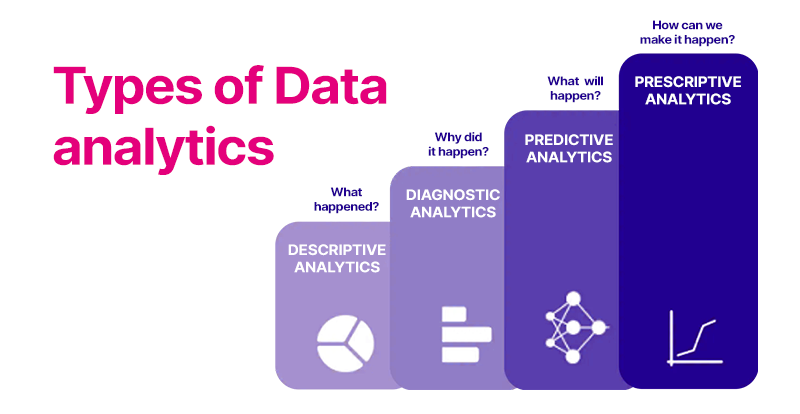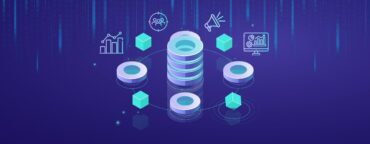Overview
A cornerstone of the process, data analysis will allow you to know your audience, activate it effectively, and build loyalty over the long term in a highly competitive market.
Explore with us the secrets of data analysis: from the different types of data to the varieties of analysis, including concrete examples. A concentrated dose of insight to boost your data strategy!
1. What is data analysis?
Data analysis is a process of collecting, processing, and interpreting data to extract meaningful and useful insights. To derive actionable information from large and varied data sets, you will need to rely on:
- a combination of statistical techniques,
- mathematical models,
- and computer tools.
The data collected may come from different sources, such as websites, social networks, mobile applications, advertising campaigns, or sales.
To go further, consult our article on Big Data and Smart Data.
2. What data can be collected?
With multiple data sources, you will be able to collect very diverse data, both qualitative and quantitative, on your market, your audience, your clients, or your performance.

a.Demographic data
Demographic data provides information about individuals’ characteristics, such as age, gender, geographic location, education level, household composition, etc.
This data helps you better understand your target audience, personalize your campaigns, and tailor messages based on users’ or prospects’ specific preferences and needs.
To collect this data, surveys, sign-up forms, and cookies can be used. You can also rely on your CRM database if this client information is available, to create relevant segmentation based on their profile.
b.Behavioral data
Behavioral data tracks users' behavior when interacting with your website, applications, or advertisements.
Thanks to data tracking, you can obtain information about the user journey, such as the pages visited, time spent on each page, actions taken (purchases, downloads, clicks, etc.), entry and exit pages, etc.
Using this data helps identify user behavior trends, optimize user experience, and increase conversion rates.
c. Interaction data
Interaction data includes users’ direct interactions with the company, whether through customer service, comments on social media, satisfaction surveys, or emails.
This includes zero-party data, which represents optional information that the consumer voluntarily provides to a company, as opposed to first-party data, which is directly collected by companies from their audiences, clients, and prospects.
This data is essential to assess customer engagement, improve brand reputation, and identify potential issues to resolve them quickly.
d. Performance data
Performance data measures the results of marketing and advertising campaigns. It provides key information on click-through rates, traffic, click-to-visit drop-off rate, conversions, revenue generated, etc.
These are valuable management tools to guide decision-making and activate the right business and marketing levers to optimize your return on investment (ROI). By analyzing this data, you are able to invest more efficiently in your campaigns and achieve your ROI objectives set in your digital strategy.
Important: In any data collection and storage process, ensure you are compliant with the GDPR or nLPD regulations in force depending on your territory. To stay up to date with the subtleties of these regulations and turn them into your best allies, check out our article.
3. How to collect and use this data?
Before implementing a data-driven strategy, you will need to choose your future tracking and analysis tools, but also be able to store your data.
a.Tracking and analysis tools
To effectively collect data, it is essential to set up tracking and analysis tools such as Google Analytics, Google Tag Manager, Matomo, Adobe Analytics, or tools specific to social media.
Implement a tracking plan to automatically collect and analyze demographic, behavioral, and performance data across your entire digital ecosystem.
You will then be able to accurately and convincingly assess the pages, content, navigation plan, or sales funnel to optimize in order to improve user experience and encourage conversion.
b. Data unification
Data often comes from multiple sources, so it is essential to integrate it into a single platform to store and obtain an overview for easier analysis.
Data unification can be done using dedicated tools or through specific CRM (Customer Relationship Management) solutions tailored to your business.
To implement and configure the best tools for tracking your data, call on an agency specialized in data analysis.
c. Using collected data
Beyond general principles, the concrete use of data analytics relies on integrating analysis into daily processes. Here are three practical levers to fully harness your data:
- Structure your data pipeline: identify your internal (CRM, ERP, website) and external (market, social media) data sources and ensure they are accessible and reliable.
- Create analysis routines: integrate analysis into your business routines — for example, via monthly performance dashboards or team reviews based on key indicators.
- Test, iterate, optimize: use your analyses to experiment (A/B testing, new segmentations), measure real impacts, and continuously adjust your actions.
By embedding analysis into action and reflection cycles, companies can truly make strategic "data-driven" decisions — or simply, data-guided ones.
4. What are the 4 types of data analysis?
When it comes to data analysis, we generally distinguish four levels: descriptive, diagnostic, predictive, and prescriptive analysis. Each of these levels provides different information and insights to help companies make informed decisions and move forward with certainty rather than intuition.

a.Descriptive analysis
Descriptive analysis is the most basic level of data analysis. It involves describing and summarizing data factually, clearly, and concisely. Its main goal is to give an overview of past events and current trends:
- Basic statistics: averages, medians, modes, standard deviations, etc.
- Charts and tables: visual representations of data, such as histograms, bar charts, pie charts, etc.
- Segmentations: dividing data into homogeneous groups to better understand their characteristics.
b. Diagnostic analysis
Diagnostic analysis aims to understand why certain events occurred by identifying the factors or causes that influenced them. It builds on descriptive analysis results to deepen data understanding:
- Correlation analysis: identifying relationships between different variables to understand how they interact.
- Regression analysis: assessing the relationship between a dependent variable and one or more independent variables to explain data variations.
- Causality analysis: determining the factors that led to a specific event.
c.Predictive analysis
Predictive analysis involves using statistical models and algorithms to anticipate customer behaviors and market trends based on past and current data. This allows businesses to make proactive decisions, optimize campaigns, and effectively target potential customers:
- Predictive modeling: using mathematical models to forecast future outcomes, such as sales predictions, market trends, etc.
- Time series analysis: forecasting future values based on historical trends over time.
- Clustering analysis: grouping similar data to identify patterns and emerging trends.
d. Prescriptive analysis
Prescriptive analysis goes beyond prediction by offering solutions and recommendations to achieve specific objectives. It helps companies choose the best course of action based on previous analysis results:
- Optimization: identifying the best combination of variables to achieve a set goal, e.g., optimizing ad spend to maximize conversions.
- Scenarios and simulations: evaluating possible outcomes based on different strategies to make informed decisions.
- Expert systems: using rules and algorithms to provide real-time recommendations.
With the recent rise of artificial intelligence, predictive and prescriptive analyses are increasingly effective and represent a real asset for companies that rely on them.
By combining these four types of data analysis, companies can get the most out of their data.
Here are a few examples of data-driven decisions guided by different types of analysis:
- For a marketing campaign: descriptive analysis might show that Wednesday emails perform better. You would then adjust your scheduling accordingly.
- For conversion rates: diagnostic analysis may reveal that cart abandonment mainly occurs on mobile. A targeted UX redesign could be initiated to fix this issue and improve the indicator.
- For sales forecasting: predictive analysis will help anticipate demand and better manage inventory.
- For pricing optimization: prescriptive models will identify the right price based on season, demand, and customer profile.
5. Data analysis tools
Descriptive analysis: visualization tools
These tools are designed to represent data in tables, graphs, and interactive dashboards. For small datasets, Excel or Google Sheets work well. For larger projects, opt for tools like Tableau and Datawrapper, better suited to dynamic visualizations and interactive dashboard creation.
Diagnostic analysis: exploration tools
The goal is to understand why an event occurred. SQL can query databases, pandas (a Python library) allows complex dataset manipulation and transformation, while Power BI and Looker facilitate visual exploration of correlations and hidden trends.
Predictive analysis: modeling tools
Predictive analysis aims to forecast the future through statistical and machine learning models. Scikit-learn and XGBoost are two robust Python libraries for training regression or classification models. Prophet, developed by Facebook, specializes in time series forecasting such as sales or foot traffic.
Prescriptive analysis: recommendation tools
These tools are designed to guide your decisions. Examples include recommendation engines (like Amazon’s or Netflix’s), mathematical optimization models for logistics or pricing, and advanced AI platforms like Google Vertex AI to automate decisions at scale.
6. Who is data analysis for?
In truth, data analysis concerns any company that wants to grow and sustain its development. However, its use varies depending on the department or role:
- For the marketing team, data plays a key role in customer segmentation and ad campaign optimization. It enables behavioral analysis and fuels A/B testing.
- For the finance department, data is used to anticipate and predict cash flows using forecasting models.
- The HR department uses internal data to better understand turnover, identify correlations between resignation rates and satisfaction, and work on talent retention.
- Management must rely on data to move forward with certainty and steer business strategy confidently, whether you're a startup or a multinational group.
Subscribe to our newsletter and gain access to strategic insights, exclusive analyses, and expert tips to enhance your online presence.
Conclusion
Data analytics is a powerful lever to help you make informed, relevant decisions, anticipate future trends, identify opportunities and potential issues — all with the goal of improving your profitability and overall performance.
By collecting and leveraging demographic, behavioral, interaction, and performance data, you develop tailored marketing strategies, enhance user experience, optimize advertising campaigns, and gain a significant competitive edge in an increasingly digital environment.
As a digital marketing agency specialized in data, Eminence is committed to helping you optimize your ROI and performance. A team of experts is ready to support you — so don’t wait, get in touch with us!








